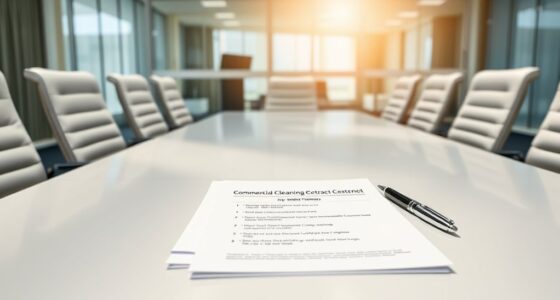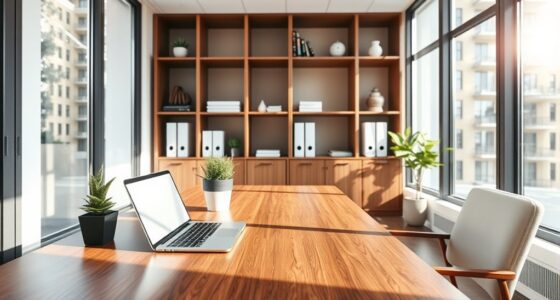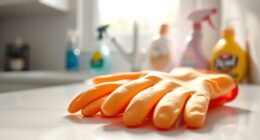To maintain restrooms in public facilities, prioritize cleanliness to enhance customer experience. Regularly check and restock supplies like toilet paper and soap. Daily clean high-touch surfaces and empty trash bins to prevent overflow. Train staff effectively to uphold hygiene standards and guarantee they focus on all surfaces, even less obvious ones. Consider eco-friendly products for sustainable practices. There’s more to explore about strategies that can keep your restrooms spotless and welcoming.
Key Takeaways
- Establish a regular cleaning schedule to ensure restrooms are sanitized frequently, especially in high-traffic areas.
- Monitor and restock essential supplies like toilet paper and soap daily to prevent shortages.
- Train staff thoroughly on cleaning protocols and best practices to maintain hygiene standards consistently.
- Focus on disinfecting high-touch surfaces, such as door handles and sinks, to minimize germ spread.
- Utilize eco-friendly cleaning products and methods to promote sustainability while maintaining cleanliness.
The Importance of Clean Restrooms in Public Facilities

When you walk into a public restroom, the cleanliness can make or break your overall impression of the facility. Clean restrooms are essential for a positive customer experience, as 86% of adults link restroom cleanliness to the overall hygiene of the establishment.
Facility managers face significant challenges in maintaining these areas, especially since 73% of people feel unsafe using unhygienic restrooms post-pandemic. Regular cleaning and maintenance not only combat germs and bacteria but also enhance the professional image of your facility.
A dirty restroom can deter customers and damage your reputation, impacting your bottom line. Prioritizing restroom cleanliness guarantees a favorable first impression, encouraging repeat business and safeguarding public health.
Challenges of High-Traffic Restrooms
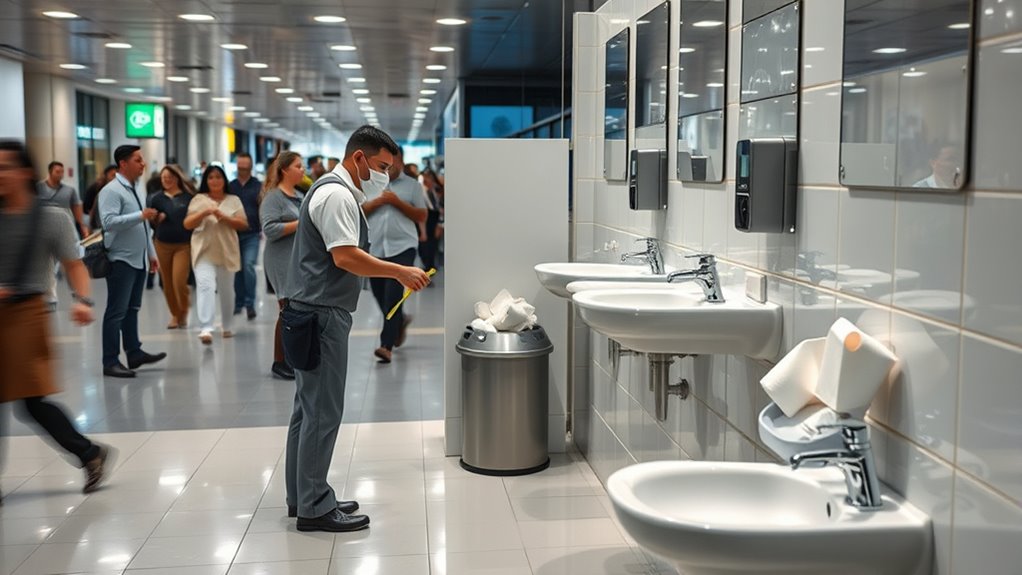
Maintaining high-traffic restrooms poses unique challenges that require strategic planning and swift action. The rapid depletion of supplies like toilet paper and soap means you’ll need a robust cleaning schedule to guarantee these essentials are always stocked.
Frequent usage increases the risk of germs and cross-contamination, making daily cleaning critical to uphold hygiene standards. Managing labor effectively during peak hours is key, as overwhelming cleaning demands can arise quickly.
With a 2020 survey showing that restrooms are a major concern for facility managers, it’s important to prioritize cleanliness. After all, 62% of Americans prefer facilities that regularly sanitize restrooms, highlighting that maintaining hygiene in high-traffic areas is fundamental for customer satisfaction and retention. Additionally, employing best practices for organizing prep tables can help minimize cross-contact risks in adjacent areas.
Essential Daily and Weekly Cleaning Tasks

High-traffic restrooms demand a reliable cleaning routine to keep them inviting and sanitary.
Start your day by checking and restocking essential supplies like toilet paper, paper towels, and soap to guarantee user satisfaction.
Don’t forget to empty trash receptacles daily and reline them to prevent overflow.
Regularly cleaning high-touch surfaces, such as door handles and sinks, with disinfectants is vital for eliminating germs.
For weekly cleaning, focus on dusting vents, polishing mirrors and faucets, and thoroughly disinfecting all flat surfaces.
Scrubbing urinals and toilets inside and out is necessary for maintaining peak hygiene.
The Role of Employee Training in Maintaining Cleanliness

While cleanliness in restrooms is vital for user satisfaction, effective employee training plays a key role in achieving and maintaining those standards. Well-trained staff are more likely to follow best practices and uphold hygiene standards consistently.
Regular training updates keep you informed about new cleaning protocols, enhancing your effectiveness in restroom maintenance. It’s important to focus on less obvious surfaces, as these can harbor bacteria that compromise overall cleanliness levels. In addition, the cleanliness of gumball machines should also be considered, as their high traffic can impact the surrounding area’s hygiene.
Strong communication among cleaning teams, supported by training, guarantees better coordination and quicker responses in high-traffic restrooms. Empowering staff with knowledge fosters accountability, which leads to improved service quality and ultimately boosts customer satisfaction in public facilities.
Strategies for Sustainable Cleaning Practices
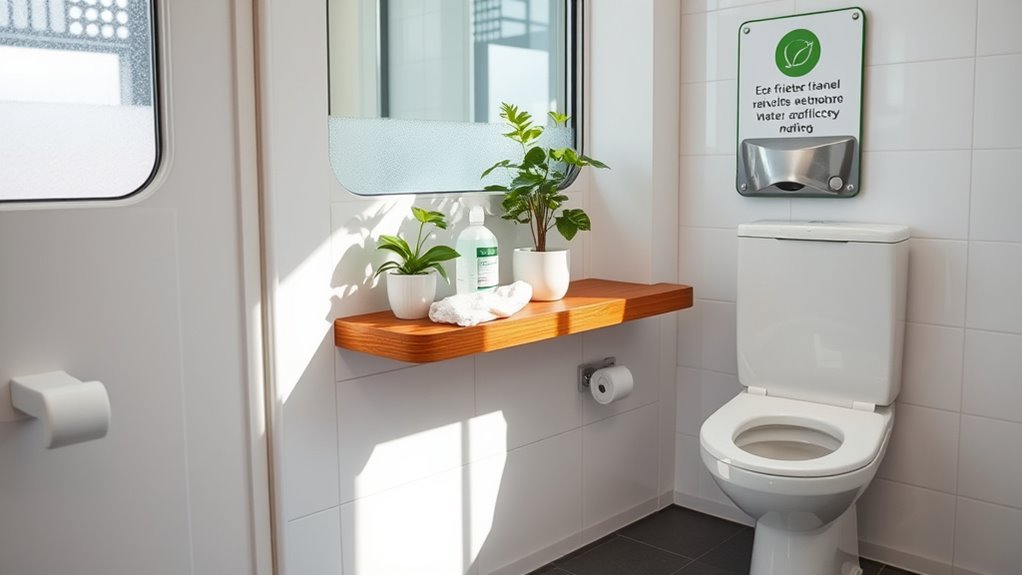
Here are some strategies to take into account:
- Switch to biodegradable cleaning products to reduce ecological footprints.
- Implement on-site generation systems for safe, eco-friendly cleaning solutions.
- Guarantee your cleaning staff receives regular training on sustainable techniques. Incorporating high-fiber foods into staff meals can enhance their overall health and productivity. Additionally, promoting air quality awareness among staff can contribute to a healthier work environment. Including raw foods such as fresh vegetables can also support staff well-being.
- Prioritize deep cleaning to effectively eliminate bacteria and viruses.
- Consider using essential oils like tea tree or lemon for their antibacterial properties during cleaning to enhance sanitation.
Frequently Asked Questions
How to Maintain a Public Restroom?
To maintain a public restroom, you should establish a regular cleaning schedule that matches foot traffic.
Focus on high-touch surfaces, disinfecting them frequently to reduce germs.
Create a checklist to guarantee you cover all cleaning tasks consistently.
Train your staff on effective cleaning techniques and the importance of thoroughness.
Finally, monitor supply levels, making sure essentials like soap and toilet paper are always available, as this greatly impacts users’ perceptions of hygiene and safety.
What Are the Ways of Maintaining Toilet Facilities?
Maintaining toilet facilities isn’t just about keeping them clean; it’s about creating a positive experience. You should regularly check supplies like toilet paper and soap, ensuring users never face inconvenience.
Implement a cleaning schedule that matches peak traffic; high-traffic areas need more frequent attention. Don’t overlook high-touch surfaces—disinfect them often.
Finally, consider tech solutions to track usage and streamline your maintenance efforts, making your facilities both user-friendly and hygienic.
What Are the General Rules for Maintaining Cleanliness in a Public Restroom?
To maintain cleanliness in a public restroom, you should regularly check and restock supplies like toilet paper and soap.
Implement a cleaning schedule that matches foot traffic, ensuring high-traffic areas get extra attention.
Focus on disinfecting high-touch surfaces, as they harbor germs.
Use a cleaning checklist to cover all areas, and make sure your staff is trained on proper cleaning protocols to promote a safe and hygienic environment for everyone.
How Can We Improve the Cleanliness of Public Toilets?
You might think public toilets are just dirty, but improving their cleanliness can transform your experience.
Start by advocating for a strict cleaning schedule that targets high-touch surfaces.
Push for touchless fixtures to reduce contact and enhance hygiene.
Make certain supplies like soap and toilet paper are always stocked, so everyone practices good hygiene.
Finally, encourage regular feedback collection to guarantee facilities meet your cleanliness expectations, especially in a post-pandemic world.
Conclusion
You might think that a clean restroom is just about appearances, but the truth is, it greatly impacts health and public perception. By prioritizing cleanliness, you not only guarantee a safe environment but also enhance the overall experience for visitors. Implementing effective cleaning practices and training employees properly can transform high-traffic restrooms from a source of dread to a place of comfort. So, let’s take these steps seriously and make clean restrooms a standard in all public facilities.





